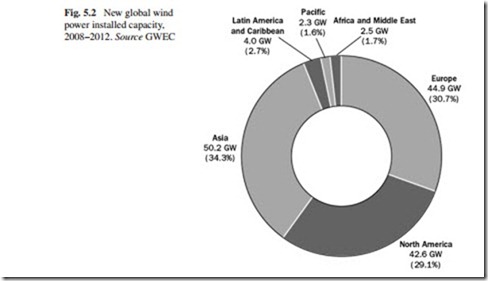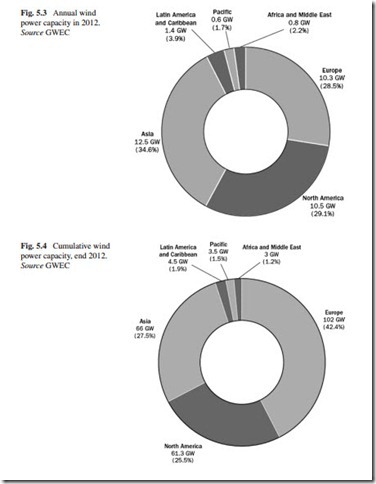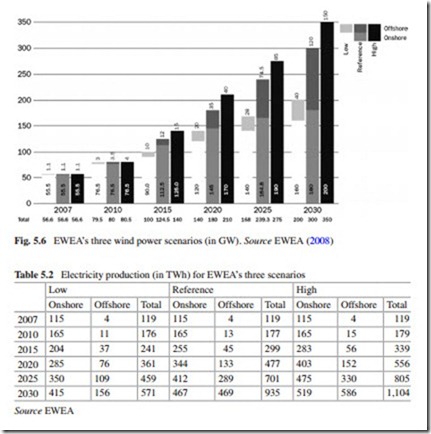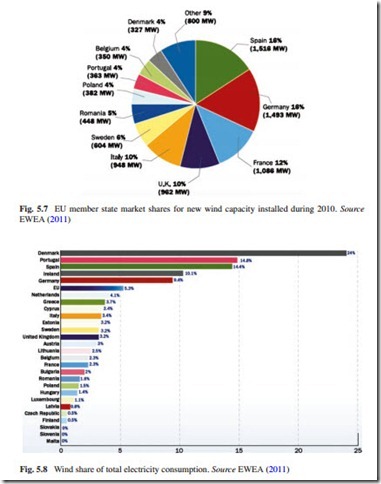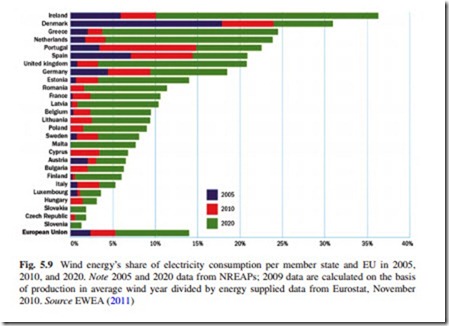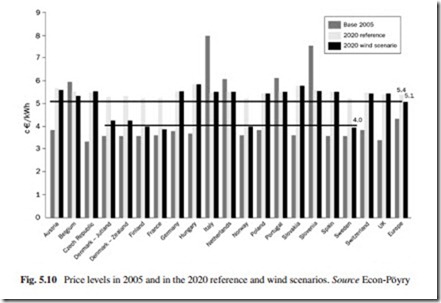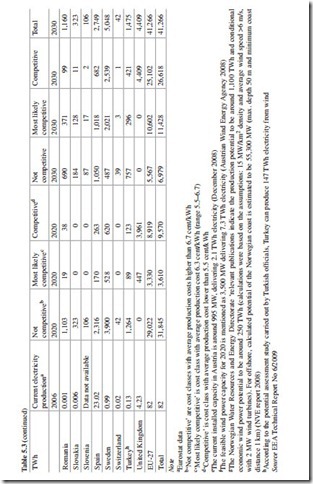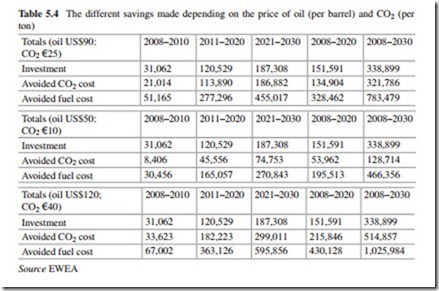The Situation in the Use of Wind Energy in Europe
The Global Wind Energy Council (GWEC) predicts that the global wind market will grow by over 155 % from 2007 to reach 240.3 GW of total installed capacity before 2013 (GWEC 2008). This would represent an addition of 146.2 GW in five
years, attracting investment of over €180 billion (US$277 billion, both in 2007 values). The electricity produced by wind energy will reach over 500 TWh before 2013 (up from 200 TWh in 2007), accounting for around 3 % of global electricity production (up from just over 1 % in 2007).
Before 2014, Europe will house the largest wind energy capacity, with a total of 102 GW, followed by Asia with 66 GW and North America with 61.3 GW. The yearly additions in wind-installed capacity are predicted to grow 12.7 %. New global installed capacity during the period 2008–2012, the new installed capac- ity added in 2012, and the total cumulative capacity in the end 2012 are shown in Figs. 5.2, 5.3, and 5.4.
Considering that wind power annual markets have been increasing by an aver- age of 24.7 % over the past five years, growth could be much stronger in the future, were it not for the continuing supply chain difficulties, which will considerably limit the growth of wind power annual markets for the next two years. This problem should be overcome by the beginning of the 2010s, and along with the development of the offshore wind market, growth rates are expected to recover in the next decade.
Before 2014, the European wind market should stand at 10.3 GW—the same size as the North American market (10.5 GW). Overall, this means that over 29 % of global new wind installations will take place in Europe before that year. In terms of total wind-installed capacity, Europe will continue to be the biggest regional market, with 42.4 % of all wind power capacity installed in the world by the end of 2012 (see Fig. 5.4).
The large-scale development of offshore wind energy will only start to have a significant impact on European market growth toward the end of a certain time period. The exploitation of the offshore wind potential in Europe brings new
challenges and opportunities for European power transmission. The long-term European offshore wind potential amounts to up to 150 GW in 2030, according to EWEA estimates made in 2008. The majority of the currently projected offshore wind plants will be situated closer to the European coastlines, not further than
100 km from the shore, due to the high costs of grid connection, limited grid avail- ability, and the lack of regulatory frameworks. Looking at the North Sea alone, with a potential of hundreds of GW of wind power, an offshore grid connecting different member states would enable the transfer of this wind power to load centers and, at the same time, facilitate the competition and the trade of electric- ity between countries. A multi-terminal offshore grid would reach offshore wind plants far from shore, as foreseen for German and UK waters (Fig. 5.5).
In Europe, Germany and Spain will remain the wind leading markets, but their relative weight will decrease as other national markets emerge on the scene. While the spectacular growth of the Spanish wind market in 2007, with over 3.5 GW of new installations, will not be sustained, a stable pace of 2–2.5 GW per year on average can be expected, enabling Spain to reach the government’s 2010 target of 20 GW. The size of the German annual wind market will decrease, but it will remain the sec- ond strongest European market for the 2008–2012 period and the biggest in terms of total wind installed capacity. Other important markets in Europe will be France and the UK, each increasing by an average of 1 GW per year (Zervos and Kjaer 2008).
According to EWEA (2011), wind energy currently meets 5.3 % of EU electricity demand in a normal year. The EC’s goal of increasing that share to 12 % by 2020 is regarded as achievable. In fact, EWEA predicts for the EU-27 to have 180 GW of wind-installed capacity, including 35 GW offshore by 2020, which is equivalent to approximately 5 % of total power supply in 2010 and between 11.6 and 14.3 % in 2020, depending on the electricity demand.
In its Renewable Energy Roadmap, the European Renewable Energy Council estimates that wind energy will reach 477 TWh by 2020 (EREC 2008). GWEC predicts wind power growth in Europe from about 41 GW in 1990 to 385 GW by 2020 in the most optimistic scenario (Greenpeace and GWEC 2006).3 In September 2010, the EC published its new EU energy scenarios “EU Energy Trends to 2030.” The scenario sees renewables generating 33 % of electricity demand in 2020, with wind energy producing 14 % (525 TWh from 222 GW installed capacity). The scenario expects 333 GW of new electricity-generating capacity to be installed in the EU in the decade from 2011 to 2020. Wind power would account for 136 GW, or 41 % of all new installations—by far the largest of any power technology optimistic scenario (Greenpeace and GWEC 2006).
In 2008, EWEA published three scenarios—low, reference, and high—for the development of wind energy up to 2030. Much of the development over the com- ing two decades will depend on the evolution of the offshore market, over which there is currently some uncertainty. The 56.5 GW of installed capacity in the EU-27 by the end of 2007 produces, in a normal wind year, 119 TWh of electricity, enough to meet 3.7 % of EU electricity demand. In terms of wind power electricity production and its share of total EU power demand, there are large dif- ferences between the three scenarios. Much depends on whether total electricity demand in the EU increases, according to the EC’s business-as-usual scenario, or stabilizes according to its energy efficiency scenario. Wind power is expected to produce between 361 and 556 TWh in 2020, and between 571 and 1,104 TWh in 2030 (see Fig. 5.6).
Table 5.2 shows that in EWEA’s reference scenarios, wind energy meets between 11.6 and 14.3 % in 2020, and between 20.8 and 28.2 % in 2030, depend- ing on how overall electricity consumption develops in the EU between now and 2030. It is assumed that the average capacity factor of all wind turbines in the EU will increase up to 30.3 % in 2020. The increase will be due to better design, exploiting the resources in more windy areas of Europe, technology improve- ments, and a larger share of offshore wind.
The peak demand (or peak load) of electricity in Europe is still increasing. For the period up to 2020, ENTSO-E (2010) expects an annual rise in the winter peak demand of 1.3–1.45 % per year and slightly higher growth (1.5–1.7 %) in the sum- mer peak demand. The peak demand is a strategic parameter because it determines
the generating and transmission capacities required. As a matter of convention, for system design purposes, peak load values at specific points of time in the year are being considered, notably in January and in July.
In terms of annual wind installations, Spain was the largest market in 2010, installing 1,516 MW, compared to Germany’s 1,493 MW. The installations of wind farms in other EU countries were the following: France 1,086 MW, the UK 962 MW, Italy 948 MW, Sweden 604 MW, Romania 437 MW, Poland 382 MW, Portugal 363 MW, and Belgium 350 MW (see Fig. 5.7). Offshore wind installations accounted for 9.5 % of total EU installations in 2010. Wind power installations accounted for 16.8 % of new installations in 2010.
In Figs. 5.8 and 5.9, the wind energy’s share of electricity consumption per member state and EU as a whole in 2005, 2010, and 2020 is included. According to Fig. 5.8, Denmark is the EU country with the highest wind share of total elec- tricity consumption (24 %) followed by Portugal, Spain, and Ireland. In 2020, it is expected that Ireland will be the EU country with the highest share of wind
electricity consumption within the EU, followed by Denmark, Greece, and the Netherlands (see Fig. 5.9).
France and Spain have the largest agricultural land area, and Sweden, Finland, Turkey, and Norway have the largest forest area. The feasible penetration of wind turbines on agricultural land is higher compared to the average feasible penetration of all land cover types. In fact, in countries where wind energy deployment is quite
high (i.e., Denmark, Germany, and the Netherlands), the agricultural land area has been most attractive for wind energy deployment. Installation of wind turbines on agricultural land can be very well combined with other uses, such as vegetable production or keeping cattle (Pimentel et al. 1994). Besides, agricultural land has relatively few obstacles, which implies a low roughness. In such areas, wind farms can be designed in an optimal way and do not need to be decreased in size or have a different layout or sub-optimal spacing.
It is important to know that there are only a limited number of wind farms installed in mountainous areas. In mid-2004, for instance, 1.5 % of turbine capacity was installed in mountainous countries in Austria, France, Italy, Slovenia, and Switzerland (Winkelmeier and Geistlinger 2004). According to the EEA Technical Report No 6/2009, lower accessibility of mountainous areas and the limited roads and grid connections result in less favorable conditions for wind farms. However, there are wind turbines at high altitudes. For instance, the highest large-scale wind park was situated at 2,330 m in Switzerland in 2004.
It is important to highlight, in the case of offshore wind farms, the follow- ing: Current and anticipated technology limits the potential for offshore wind energy generation. First, no wind speed data have been collected from offshore areas with a depth of more than 50 m. Second, wind turbine developments in such deep waters are considered not to happen within the limits of current technology. Currently, wind farms are with a few exceptions, placed in shallow waters, with depths up to about 25 m. The offshore technical potential in 2030 is estimated at 30,000 TWh for all EEA countries. This figure is two-thirds of the onshore (unrestricted) technical potential (45,000 TWh). If the increase in the use of wind power projections was correct, then this would mean an annual business worth of some €80 billion.
It is important also to highlight that 80 % of today’s world capacity is located in just five countries, Germany, Spain, Denmark, the USA, and India, three of them in the European region. In terms of overall capacity, Germany will continue as European leader, with a total installed capacity of 20,622 MW, followed by Spain with 11,615 MW and Denmark with 3,136 MW.
The worldwide development of wind power installations now includes the planning of large-scale wind farms, ranging in the magnitude of 100 MW, and is considered to constitute a significant part of the renewable power production planned in Europe and in the world. This is a challenging development that will have an impact on the power system stability and operation. The development is sound; however, wind power is a cost-effective renewable energy source that can smoothly be integrated into the power system by applying adequate control technologies and market-based solutions. It is important to be aware that wind energy is by nature a fluctuating source of power. In a system where a significant part of the power generation comes from wind, system operational issues, such as frequency regulation and congestion management, become a challenge due to the normal variations in the available wind power. Systems with a substantial supply from wind farms, thus, call for flexible and improved solutions with respect to secondary generation control.
Wind Energy Price
In the EU, the expected price level is around €5.4 per kWh on average in 2020 in the reference case (Fig. 5.10) with a slightly higher price on the continent than in the Nordic countries, but with smaller price differences than today.
In the wind scenario, the average price level in the EU decreases from €5.4 to €5.1 per kWh compared to the reference scenario. However, the effects on power prices are different in the Nordic countries than in other countries on the European continent.
In the wind scenario, wind energy reduces power prices to around €0.4 per kWh in the Nordic countries. Prices in Germany and the UK remain at the higher level. In other words, a larger amount of wind power would create larger price differences between the Nordic countries and the European continent. One
implication of price decreases in the Nordic countries is that conventional power production becomes less profitable. In Norway, hydropower counts for the major part of the power production. However, large-scale implementation of wind creates a demand for flexible production that can deliver balancing services—opening up a window of opportunities for flexible production such as hydropower.
Finally, it is important to highlight the following: According to the EEA Technical Report No 6/2009, wind turbines are often installed in distant regions far from major electricity consumption. Large portions of the electricity pro- duced must therefore be transported over large distances to load centers. This could lead to congestion of existing infrastructure. Therefore, higher penetration levels in both the transmission and the distribution grid might require additional extensions or upgrades. These upgrades can also be on a cross-border level. The “Wind Energy—The Facts” publication reviewed several country-specific studies and concluded that (both onshore and offshore) the grid extension and/or reinforcement costs caused by additional wind generation are in the range of €0.1–€5 per MWh for penetration levels up to 30 %.
Table 5.3 includes the generation potential of wind energy on land in different cost classes and in the EU-27.
The 8,554 MW of wind power capacity that was installed in the EU in 2007 had an investment value of €11.3 billion and will avoid CO2 emissions worth €6.6 billion throughout its lifetime and fuel costs of €16 billion throughout its lifetime, assuming an average CO2 price of €25 per ton and average fuel prices (gas, coal, and oil) based on US$90 per barrel of oil. Similarly, the €152 billion of investments in wind power between 2008 and 2020 will avoid €135 billion worth of
b‘Not competitive’ are cost classes with average production costs higher than 6.7 cent/kWh c‘Most likely competitive’ is cost class with average production cost 6.3 cent/kWh (range 5.5–6.7) d‘Competitive’ is cost class with average production cost lower than 5.5 cent/kWh eThe current installed capacity in Austria is around 995 MW, delivering 2.1 TWh electricity (December 2008) fThe feasible wind power capacity for 2020 is mentioned as 3,500 MW delivering 7.3 TWh electricity (Austrian Wind Energy Agency 2008) gThe Norwegian Water Resources and Energy Directorate ‘relevant publications indicate the production potential to be around 1,100 TWh and conditional economic wind power potential to be around 250 TWh (calculations were based on the assumptions: 15 MW/km2 density and average wind speed >6 m/s, with 2 MW wind turbines). For offshore, calculated potential of the Norwegian coast is estimated to be 55,300 MW (max. depth 50 m and minimum coast distance 1 km) (NVE report 2008) hAccording to the potential assessment study carried out by Turkish officials, Turkey can produce 147 TWh electricity from wind
CO2 and €328 billion in fuel cost under the same assumptions. For the period up to 2030, wind power investments of €339 billion will avoid €322 billion in CO2 cost and €783 billion worth of fuel (Zervos and Kjaer 2008).
From Table 5.4, the following can be stated: Changing the CO2 and fuel price assumptions has a dramatic impact on the result. With low CO2 prices (€10 per ton) and fuel prices (equivalent to US$50 per barrel of oil) throughout the period, wind power investments over the next 23 years could avoid €466 billion instead of €783 billion. With high prices for CO2 (€40 per ton) and fuel (equivalent to US$120 per barrel of oil), wind power would avoid fuel and CO2 costs equal to more than €1 trillion over the three decades from 2000 to 2030.
Finally, the following are a summary of the wind industry target for the EU-27 in 2020 and in 2030:
2020
• 180 GW installed capacity, including 35 GW offshore;
• Annual installations of 16.8 GW, including 6.8 GW offshore;
• Electricity production of 477 TWh, including 133 TWh offshore;
• Meeting between 11.6 and 14.3 % of total EU electricity demand (depending on 2020 demand);
• 18.1 % of total installed electricity-generating capacity in the EU;
• 32 % of total new electricity-generating capacity installed (2011–2020);
• Providing power equivalent to the needs of 107 million average EU households (49 % of EU households);
• Avoiding 328 Mt of CO2—equivalent to taking 165 million cars off the road (76 % of the EU 2004 car fleet) and equal to 44 % of the EU’s GHG reduction target (20 %);
• Annual avoided fuel cost of €20.5 billion (assuming fuel prices equivalent to US$90 a barrel of oil);
• Annual avoided CO2 costs of €8.2 billion (€25 per ton CO2);
• Annual investments in wind power capacity of €16.9 billion;
• Total wind power investments of €120 billion (2011–2020);
• Total lifetime avoided fuel costs of wind power capacity installed in 2011–2020 of €277 billion (assuming fuel prices equivalent to US$90 a barrel of oil);
• Total lifetime avoided CO2 cost of wind power capacity installed in 2011–2020 of €114 billion (assuming €25 per ton CO2) 2030
• 300 GW installed capacity, including 120 GW offshore;
• Annual installations of 19.5 GW, including 9.6 GW offshore;
• Electricity production of 935 TWh, including 469 TWh offshore;
• Meeting between 20.8 and 28.2 % of total EU electricity demand (depending on 2020 demand);
• 25.5 % of total installed electricity-generating capacity in the EU;
• 46 % of total new electricity-generating capacity installed (2021–2030);
• Providing power equivalent to the needs of 195 million average EU households (84 % of EU households);
• Avoiding 575 Mt of CO2—equivalent to taking 285 million cars off the road (132 % of the EU 2004 car fleet);
• Annual avoided fuel cost of €34.6 billion (assuming fuel prices equivalent to US$90 a barrel of oil);
• Annual avoided CO2 costs of €14.4 billion (€25 per ton CO2);
• Annual investments in wind power capacity of €19.4 billion;
• Total wind power investments of €187 billion (2021–2030);
• Total lifetime avoided fuel costs of wind power capacity installed in 2021–2030 of €455 billion (assuming fuel prices equivalent to US$90 a barrel of oil);
• Total lifetime avoided CO2 cost of wind power capacity installed in 2021–2030 of €187 billion (assuming €25 per ton CO2) (EU 2006).
